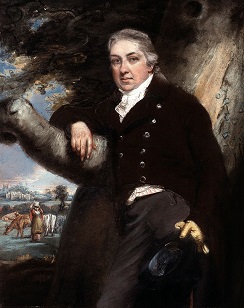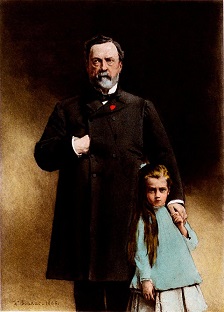In 64 episodes, we painted a picture of mankind gradually getting the upper hand over infectious diseases with the aid of its chemical knowledge. And of the limits to this process, as we now run into the ‘new’ but very natural phenomenon of resistance. We will never be able to transcend this. What do we learn from history here? What are our options? In 4 episodes we will try to paint this perspective. We finish with 3 columns that formulate our view on the future of the pharmaceutical industry.
Project ‘100 years of antibiotics’
Episode 63. Modern vaccines
Episode 64. Fungal infections
Episode 65. Limits to human power
Episode 66. The evolutionary arms race
Episode 67. Technological development, major changes

Infections
Mankind has been struck by plagues throughout history. Uncontrollable conditions that we had to allow to peter out, whatever the cost. Among them many bacterial infections: the plague, cholera, tuberculosis, leprosy, typhoid. And some viral infections: smallpox, measles, the flu. Many plagues are very painful because they take their toll particularly from children.
Plagues are mentioned in records from Antiquity already, even though we often don’t understand what the condition in question was. Europe has been struck by epidemics of the plague, from the 14th century onwards. The 1919 Spanish flu takes the lives of 50 million, much more than the toll of the First World War (15 million). For Covid, the toll is at least 6 million, but even in this modern age the actual number cannot be established with great accuracy.
Quarantine
From the Renaissance onwards, people gradually learn how to control infectious diseases. The plague for instance can be met to a certain extent with a systematic quarantine. People in households struck by this condition have to live in seclusion, they cannot have contact with anybody else. Those with whom they have been in contact, should be warned; they will have to restrict their contacts as well.
But in the 18th and 19th centuries, infectious diseases are on the rise again, both in number and in seriousness. Their cause being that the world becomes more international; the number of contacts between countries rises, and with them the opportunities of infectious diseases to spread. In the course of the 19th century, people get convinced of the importance of hygiene. Pasteur contributes much to this new insight. As a result, the number and seriousness of infections goes down again.

Infection control
This is also the age in which scientists develop methods to control infections. Early 18th century inoculation against smallpox, a method used in Asia and Africa as well. This process consists of infection through the skin (whereas the smallpox infection commonly results from inhaling the germs). Such an inoculation results in a much less serious course of the disease. By the end of the 18th century, the British doctor Edward Jenner proves that an infection with cowpox will result in an immunity to smallpox. The start of the vaccination of children against smallpox that has been practiced for many years. In the ‘70s of the past century finally, this scheme has been ended because the smallpox virus had been eradicated.
There are still plagues nowadays, but only under exceptional conditions. In wartime, if there aren’t enough medicines available to meet the infection (see the outbreak of polio in the Netherlands during World War II). Or if the condition is new and people haven’t yet developed a defence against it. Like with HIV/aids from the ‘80s of the past century onwards – a sexually transmittable condition. By the end of 2007, 33 million people were infected with HIV, of which 22 million in Southern Africa. That year, about 2 million people died from this condition. In Western countries, infectious diseases have lost much of their prominence, but they still are very common in developing countries. There, up to 50% of deaths may be attributed to infections. Like HIV/aids, Ebola, tuberculosis. In the case of corona, we witness how fast the picture can change: almost half a billion contaminations already. Although, at the same time: humanity never intervened as fast and as successful before.
Belief in progress
In world history, Europe’s development is exceptional. From the Renaissance onwards, people adhere to a belief in progress: the conviction that the world will become a better place through a process of continuous improvement. Science is such an exciting new discovery; the methodical study of reality. It will lead us to ‘true knowledge’. A bottom-up approach in which the body of knowledge grows all the time; fundamentally different from the top-down approach of mediaeval scholastics.
This is the time when the world discovers the connection of science and technology. The principle that we can better control nature by accumulation of our knowledge. Until then, science and technology belonged to different worlds. The ancient Greeks considered the argued proof of an axiom to be more important than its demonstration in practice. Consequently, science wasn’t much oriented towards practical application, whereas technology was a craft first and foremost.

Control of nature
The most important herald of the new vision is the British philosopher Francis Bacon (early 17th century). He views science and technology together as the agents of progress. Technical achievements will carry us control and adaptation of nature; and ultimately the accumulation of health, wealth and happiness. This belief in progress will stay leading in mankind’s philosophies until well into the 20th century: the Club of Rome’s Limits to Growth report (1973) will finally mark the end to this era.
But this intricate connection between science and technology, essential to the modern view as it is, will be confined to theory for a long time at first. Yes, in 1687 Newton successfully applied mathematics (a science) to the computation of the ballistic trajectory (a technique). But still, for a long time to come, technological development is experimental rather than theoretical, by trial and error. Done by craftsmen rather than by scientifically trained engineers. For instance in the development of the steam engine in the 18th century, the device that will set in motion the industrial revolution. It is not until the rise of thermodynamics in the 19th century that scientists can apply their knowledge to improvement of this instrument.
The new tools and their limits
Chemistry, the subject of this series, starts humbly by the end of the 18th century. Ultimately, chemistry will lend us an insight into nature’s processes; from then onwards, we can apply chemical knowledge to the control of toxic bacteria. But here as well, development is slow. In the beginning, chemical knowledge is just about non-living matter. The insight that chemical reactions also happen in living creatures comes slowly, by the end of the 19th century. In 1897, Eduard Buchner demonstrates that a biochemical reaction (fermentation) can also be shown to take place outside living creatures; the final proof that these too undergo chemical reactions. Buchner’s discovery marks the start of biochemistry as a scientific discipline.

Another 19th century discovery is that illnesses are caused by toxic microorganisms. A discovery made by Louis Pasteur in France and Robert Koch in Germany. But here as well, it only dawns after some time that chemistry (as a science) can be of assistance in the (technical) job of the doctor who tries to control the condition. An insight to which Paul Ehrlich contributed much. He investigated the relationship between the chemical formula and the medicinal activity of the compound.
A new era
The importance of chemical science grows a lot in the course of time. By 1900, the doctor has just a few dozens of medicines at hand with which he can cure illnesses. But the knowledge of the causes of conditions, and of ways to control them, grows fast from then onwards. There is a spectacular growth in the number of medicines available to the doctor, to hundreds around 1960 and many more afterwards. Science makes new discoveries all the time.
In this process, the development of (first) sulfas and (then) penicillin marks a breakthrough. Infectious diseases that seemed to be untreatable, can suddenly be cured. A new era seems to have begun. Progress in our times! And this breakthrough has its parallels. In insect control, a similar process develops. DDT seems to be a miracle agent. The substance can kill vermin. As it seems, mankind is at the brink of an era without infections. The 1944 invasion in Normandy would not have been successful without the contribution of DDT, that kills the insects in ample supply.

Disappointment
Between 1945 and 1970, the miraculous substances penicillin and DDT seem to mark the beginning of a new era. But disappointment comes, and limits appear, rather quickly. In the case of DDT, insects develop resistance; they are no longer killed by the insecticide. As a matter of fact, in the beginning DDT does kill most insects; but the few that survive have better resistance towards the insecticide. Ultimately, an offspring develops that can hardly be controlled by DDT (for instance), and mankind therefore needs to develop stronger insecticides. Moreover, the substance kills ‘higher’ animal species as well, like birds, if they eat insects. For the substance doesn’t break down in the body and therefore heaps up. A process compellingly described by Rachel Carson in her book silent Spring.
The same mechanism pops up in the use of penicillin. Strains of resistant bacteria develop, that in the end render the product ineffective. Particularly in locations where the medicine is much used, like in hospitals. The phenomenon of resistance shows mankind’s limited power.
The change
The change comes in the ’70s of the 20th century, an era of major developments. Belief in progress wanes. A process that comes from both sides. From the outside: the world cannot be engineered – testified to by the newly discovered phenomenon of resistance. And from the inside, because the concept of progress as such is being questioned. Optimism goes, scepticism and even pessimism come. Economic growth cannot go on forever. It is the time in which Western youths rebel. They have lost the belief in continuous progress – at any rate by more wealth.
The ‘70s mark a turning point in Western history. Belief in progress now makes way for a much more sceptical view. After an era in which problems were there to be solved, now people take a much more sceptical stand. ‘Maybe solutions don’t exist, and then muddling through is the best we can do. Going on from remedy to remedy for the time being, knowing that the search for solutions has its limits.’ Those who adhere to the belief in progress are now more and more being perceived as seducers to unnecessary consumption.
Limits
Control of toxic organisms is a clear example of this new attitude. We run into limits: our remedies become less effective all the time, we need to look for new medicines continuously. We often promise more than we can deliver. Living nature develops resistance. A consequence that we cannot evade. systems theory leads us to the same outcome: systems are characterized by feedbacks, and therefore the uninhibited pursuit of one strategy will always meet its limits. A consequence we can only evade by pursuing a different strategy from time to time.
In the end, we develop a new view of reality. We don’t look upon solutions as being final anymore. Rather we know that each ‘solution’ will meet its limits; in the end it will turn out to be the gateway to new problems. We will always find solutions; even though we haven’t yet quite internalized the idea that these will always be temporal.
